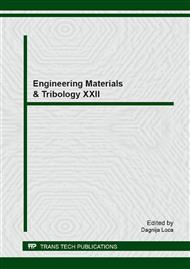p.32
p.36
p.41
p.47
p.51
p.55
p.59
p.63
p.67
Contact Fatigue Life Investigations and Wear Mechanisms of Different Case Hardened and Nidrided Steels
Abstract:
The present work examines experimentally the local damage evolution and compares the differences in fatigue behaviour of case-hardened and plasma nitrided layers under rolling contact fatigue (RCF). The RCF experiments are accompanied by damage assessments. In order to assess experimentally the extreme conditions of point contact, the experiments are performed on a ball-on-rod (BoR) test rig. Results showed that nitrided surface get more important to RCF at lower contact pressure due to the comparable thin nitration depth, whereas at high contact stress the crack initiation starts on the surface of the compound layer and crack grow further in the diffusion layer. The carburised layer of case-hardened surfaces do not show any surface crack initiation.
Info:
Periodical:
Pages:
51-54
Citation:
Online since:
March 2014
Authors:
Price:
Сopyright:
© 2014 Trans Tech Publications Ltd. All Rights Reserved
Share:
Citation:


